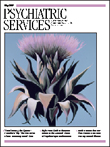Frontline Reports
A Peripartum Inpatient Psychiatric Program for Mothers and Infants
In 1999 Geneva University Hospitals set up a medical-psychiatric unit located in the district general hospital, which is nearby the maternity and pediatric hospitals. This arrangement encouraged referrals of mothers and infants with a variety of perinatal problems and led to the development of a specific program, which received the Geneva University Hospitals' Quality of Care Award in 2003.
Women are referred to the program from the psychiatry and emergency departments, the maternity hospital, and private practitioners. Children in good physical health, from birth to walking age, but mostly between one and six months of age, can be admitted with their mothers. Indications for psychiatric hospitalizations are usually postpartum depression or psychosis and substance-related disorders during pregnancy, both of which are often associated with major psychosocial problems. Before the program was implemented, these patients would go to the district psychiatric hospital.
Care is focused on puerperal difficulties and the potential family crisis induced by childbirth. Much attention is devoted to the prevention of mother-child attachment disorders. The unit's social worker and psychologist help carry out a multidisciplinary approach. A midwife associated with the maternity hospital organizes pregnancy and postpartum follow-up. This approach allows for continuity of care between the obstetrics-gynecology and psychiatry departments. A collaboration with the pediatric hospital was developed to facilitate the mother-child attachment process when the baby is hospitalized in that facility. Some of the professionals at the pediatric hospital who are involved in the collaboration work in our program on a regular basis, which guarantees ongoing institutional links and communication.
Because our peripartum program was started in response to urgent demands, all the medical-psychiatric unit's nurses were involved from the beginning. The nursing and medical teams showed strong motivation despite the extra work and supervision. Experience shows the importance of joint hospitalizations for the assessment of mother-baby interactions, because some important elements are not apparent with brief observations, such as the mother's tolerance for the baby's crying, her anxiety about being separated from the baby, or on the contrary, her tendency to rely on the team for his or her care. We established a mother-baby observation scale to document two key interactions for babies up to three months old: feeding and bathing. Familial support is evaluated through encounters with the patient's relatives, and couple sessions are encouraged when appropriate. The mother's investment in her new role is also assessed through her interactions with other patients. These social contacts take place either informally or in groups addressing the experience of hospitalization that aim to preserve a calm ward atmosphere. Specific therapeutic activities include cognitive-behavioral interviews with a psychologist. During these sessions, the focus is on the experience of motherhood and related life changes. A body-centered approach is also proposed to patients; during weekly sessions with a trained therapist, they are encouraged to feel and express sensations aroused by mother-baby physical contacts.
A total of 74 patients have been referred since the beginning of the program, and 32 mothers were, at some point, hospitalized jointly with their babies. Twenty-one patients' babies were either hospitalized in the pediatric hospital or taken care of by the family, with daily contacts in order to minimize mother-baby separation. In four cases, the mother was first hospitalized alone and after significant clinical improvement was joined by her baby. Twenty-nine women were hospitalized during pregnancy. Among these women, five had an abortion. Three patients were admitted during their pregnancy and remained in the unit after childbirth, while their babies were hospitalized in the pediatric hospital. Only once did we have to interrupt a joint stay and transfer the child to the pediatric hospital because the mother's mental state could have threatened her baby's life.
Implementation of the program led to no extra costs, because only preexisting resources were mobilized. Interestingly, mean length of stay was shorter for the peripartum program than for the general medical-psychiatric program (20.5 days compared with 25.5 days). On average, one or two mother-baby pairs are hospitalized at a given time. In one exceptional circumstance, four mother-baby pairs were present in the unit over a three-week period. Rooms are equipped on admission day.
Patients' satisfaction appears to be high, because most mothers keep in touch with the unit, sending letters of gratitude and pictures of their children, even long after discharge. In terms of the other patients, we noticed that the presence of a baby is always well accepted and sometimes has a positive impact by decreasing aggressiveness. Indeed, most patients appear sensitive to maintaining a calm ward atmosphere and seem capable of putting their own difficulties into perspective.



